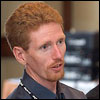
 About JCP
Get Involved
Community Resources
Community News
FAQ
Contact Us
About JCP
Get Involved
Community Resources
Community News
FAQ
Contact Us

|
 |
2005 may be remembered as a year of eating cake. I had the amusing honor of singing "happy birthday" and eat cake in Sao Paolo, Ede, San Francisco, Tokyo and a couple more places as many Java groups and organizations around the world wanted to be part of the 10th year of Java technology.
Together we journeyed from being amazed at a dancing Duke in a web page to the full-frame, full-speed 3-D graphics in today's computer games, all with the same technology. Just this year itself many achievements and events took place that deserve a mention. With then the purpose of sharing my thoughts with you of what can be behind some this and what they may mean for the year ahead.
Let's start with the Java Community Process (JCP) program Membership. The size of the membership continued its increase and this year, just as in previous years, the community increased by about 12-15%. Perhaps not too surprising. What pleased me is that the Java Community has become more inclusive of the industries and geographies around the world as illustrated by SouJava's joining from Brasil (the world's largest JUG and the first JUG to join),
Tata Elxsi from India (worldwide provider of customized design solutions) and ChinaMobile from China (the first mobile service provider from that country to join).
 |
|
| Onno Kluyt |
 |
An effort I lead at Sun in support of the goals of the JCP program is Sun's Technology Compatibility Kit (TCK) Scholarship Program. Established in 2002, the scholarship helps ensure that the cost of the rigorous compatibility testing process is not a barrier for not-for-profit organizations, universities or qualified individual developers who want to build compatible implementations of Java Specification Requests (JSR) led by Sun.
Quite a number of projects benefitted from this scholarship since it was established. In August Sun extended the program for another three years. At http://java.sun.com/scholarship/ you'll find a list of scholarship recipients and the set of qualifications applicants are required to meet. You can send any questions you may have and applications to the Review Board at tck-review-board@sun.com.
One scholarship I would not at all be surprised to receive in the new year would be one from Project Harmony by Apache Software Foundation for the Java SE 5 technology test suite.
Speaking of open source software, 2005 saw a further proliferation of this methodology and lifestyle. Apache's Harmony project is an example. Sun played its own part by moving its implementations of Java EE 5 and JSR 208, Java Business Integration under the CDDL license.
At java.net you can directly participate in the development of the next versions of the Java SE and Java EE platforms. While the Java SE 5 and Java SE 6 projects (aka JDK Community) are not so far using an open source software license, I call them out here as examples of how not just open source software as a licensing model continued its march in 2005 but that the lifestyle it represents, if you will the desire for openness and transparency, also continues its march. Which will clearly carry forward in 2006.
Within the JCP all this plays too. Compared with a few years ago, participants in the community and observers from the side will now expect (and often demand) the specification development process itself also to be more visible, more tangible and have higher interactivity. The JCP took strides towards this trend when in JCP 2.6 it made basic rule changes to make all spec review public, to make an Expert Group's work transparent through observers and other means. My team, the JCP Program Office, will be focusing on two things the coming year that speaks to this.
We will encourage and entice Spec Leads and Expert Groups as transparent, open, participative and inclusive as they have the courage to be. And we will be rolling out substantive changes to the JCP.org site, providing broad sets of tools to Spec Leads and Expert Groups so that they can easily develop specifications collaboratively and interactively with the community at large.
Spec Leads have one of the hardest jobs in the Java community: to bring together a group of developers of differing walks of life and with often competing goals to develop high quality Java technology specifications that will enjoy wide adoption, and do all that on predictable and reasonable schedules. Compared with the first 3 years of the JCP program, JSRs now complete a 100 to 120 days faster on average.
To recognize the hard work and expertise (both technically and often also psychological) of these developers, the JCP started in 2005 the Star Spec Lead program. We will continue this in the new year. The goal of this program is not just to give these individuals well- deserved attention but also to enable the transition of their expertise to fellow spec leads and community participants as to continue to raise the knowledge-level and performance of the Community.
This year saw the return of the first Java technology to enter the Java Community Process program. The Real-time specification for Java technology was the effort that started the JCP program in December 1998. Now, this group of industry experts have started JSR 282 to develop the next version of this technology which should complete during the course of 2006. You should be able to look forward to many great JSRs to finish in 2006: Java EE 5 (JSR 244), Java SE 6 (JSR 270), Mobile Architecture for CLDC (JSR 248), Mobile Architecture for CDC (JSR 249), and mid-P v3 (JSR 271) among many others.
Stay tuned to jcp.org for more cool JCP program activities and opportunities to participate acively in Java technology standards innovation. And if you're not a JCP member already consider becoming one as one of your new year's resolutions!
| |